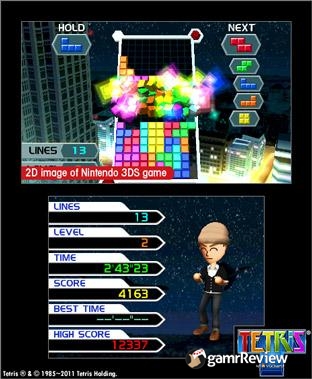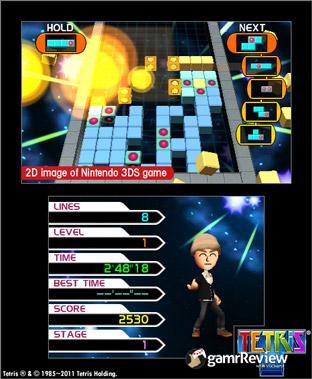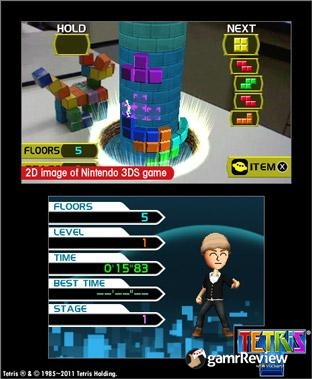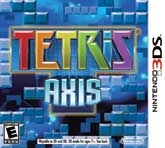
Tetris Axis - Review
by VGChartz Staff , posted on 01 November 2011 / 4,962 ViewsTetris is partly responsible for the massive success of the original Nintendo Gameboy. Over the years Tetris has redefined the term longevity, appearing on a wide variety of platforms in various incarnations and yet still managing to retain its tremendous popularity. Tetris DS was a great game for that platform early in its lifecycle and now there is Tetris Axis for the Nintendo 3DS, one of the few titles thus far to take advantage of nearly all of the new handheld's unique features.
 At the heart of Tetris Axis is the core Tetris gameplay itself. You know the basics: you arrange falling blocks of various shapes to clear lines from the playing field in order to achieve a high score. In Marathon mode this is all you’re doing. The matrix is set against an urban skyline with planes flying in the background, and the blocks are lit in bright neon colors that make them stand out from the dark city backdrop. You move blocks around with the D-pad, rotate them with a face button, and only use the shoulder buttons to swap the tetrominoes in your reserve. The bottom screen displays your Mii, what level you have reached so far, and your playtime. Here the 3D effect is subtle but effective. After you clear a line, neon text of encouragement flashes in the matrix and the blocks fly towards the screen before disappearing.
At the heart of Tetris Axis is the core Tetris gameplay itself. You know the basics: you arrange falling blocks of various shapes to clear lines from the playing field in order to achieve a high score. In Marathon mode this is all you’re doing. The matrix is set against an urban skyline with planes flying in the background, and the blocks are lit in bright neon colors that make them stand out from the dark city backdrop. You move blocks around with the D-pad, rotate them with a face button, and only use the shoulder buttons to swap the tetrominoes in your reserve. The bottom screen displays your Mii, what level you have reached so far, and your playtime. Here the 3D effect is subtle but effective. After you clear a line, neon text of encouragement flashes in the matrix and the blocks fly towards the screen before disappearing.
Axis boast over 20 modes of play but as you’d expect not all achieve the same level of addictiveness and replayability as the classic mode. The ones that hold your attention but also bring something unique to world of Tetris are: Fit, Tower Climber, and Stage Racer Plus. Fit tasks you with twisting the familiar four block shapes in order to fill in the gaps in an incomplete grid of blocks floating in space. You rearrange the shapes with one button then fire them into the right spot with one of the shoulder buttons. The grid moves towards the screen faster as you play, and if it reaches the screen before you place the pieces it's game over. Becoming increasingly challenging, it eventually requires you to think abstractly in order to fit several different blocks in each level.
In Tower Climber your objective is to guide a nondescript avatar up a cylindrical tower by placing tetriminoes in his path. In addition to figuring out how to reach the top you also have to keep your climber alive by picking up hearts before his health meter depletes. This one tests your ability to think on your toes; the climber can only climb up one block at a time and will always use the closest unobstructed route, so sometimes this means bypassing health pickups in hopes of reaching the tower summit before your time runs out. As you play, the blocks fall faster, and there's a chance that you'll entrap your character between pieces. If that happens you can use an item that causes a UFO to swoop down and remove a few pieces from the top of your pile. Tower Climber is definitely one the better twists on the Tetris gameplay to come around in recent years and can get quite addictive.

Stage Racer Plus has you racing through a course using tetriminoes. You must keep pace with the scrolling camera by twisting the shape you are controlling in order to smoothly navigate the obstacles on the course. You have the ability to jump over obstacles but this is limited, though there are additional pick-ups available.
Meanwhile, Sprint is a challenge to see how fast you can clear 40 lines in a game of classic Tetris; Master Mode tests your line-clearing ability with tetriminoes falling at maximum speed from the onset; and Jigsaw has you arranging puzzle pieces to match a picture found on the bottom screen.
My least favorite modes were Capture, Shadow Wide, and Bombliss Plus. In Capture, your goal is to cover stars at the front and rear of the matrix to obtain them, with the time it takes to capture these stars determining your score. Shadow Wide has you placing the tetriminoes to match the outline of shapes such as a house in the playing field. You are judged on the percentage of the shadow you are able to fill, minus the pieces you used that fell outside of the picture. Bombliss Plus tasks you with clearing a partially filled playing field by clearing lines with bomb-laden tetriminoes. My gripe with each of these modes, aside from the general lack of excitement they bring, is that they each have a tendency to be muddled with too much time spent clearing lines in order to correct your mistakes before you can return to your main objective.
The AR mode is restricted to the Marathon and Tower Climber modes. Neither one is changed from a gameplay perspective, though it's a novel sensation, playing the game as if it were right in front of you. The playing field slowly rotates and expects you the keep up with it even as you play. Things get a tad annoying if you are unable to keep the 3DS’ camera lined up with the AR card - the game halts for short spurts until you are able to realign properly, though this shouldn't be a problem if you play in an area with enough room to move around. It's cool to show off to others that may be watching, but not really ideal if you're playing by yourself.

Tetris Axis also boasts numerous multiplayer options. You can play locally, through download play, or via the internet. Up to eight players can battle each other, attempting to clear the most lines and increase the amount of pieces inhabiting the opponents’ playing field. You can also use items that either help you or hinder someone else (sometimes both). These items make good use of the 3DS’ various input methods, such as swiping across the touchscreen to scatter pieces across an enemy’s matrix, shaking the system to swiftly and neatly re-organize your own matrix, and even blowing into the microphone to clear fog. SpotPass is also featured, allowing players to collect items to use in Fever Mode.
Mii integration is disappointingly weak. They dress and dance on the bottom screen like that one friend you never invite to the club in fear of embarrassment. When you are in danger of losing they jump around frantically until you recover and either jump around in victory or bend over in defeat depending on how well you do overall. More varied animations, and even small tweaks like replacing the white featureless avatar featured in Tower Climber with your Mii would have been highly beneficial.
The familiar Tetris tune is of course present, here mashed together with a tune from The Nutcracker, which the soundtrack borrows from quite a bit (subliminal advertising ahead of the holidays?). Upbeat classical music and playful electronic sounds fill out the rest of the audio design, and all fit the title well. The visuals make subtle use of 3D and many of the modes feature unique and dynamic backgrounds that change as you play; interesting to look at without distracting you from the gameplay. Menus, on the other hand, feature an unseemly clash of neon colors.
Tetris Axis retails for $29.99 MSRP, 10 dollars less than most 3DS games. Quite a bargain considering the amount of content packed into this release and its inherent replayability. However, many of the game modes found here can be found in numerous other versions of Tetris. And yet a good puzzle game is a must for any portable system’s library - Tetris Axis is one of the best you’ll find on the 3DS.
While not a definitive anthology of Tetris’ best modes and features, Tetris Axis is a very solid iteration that fits well on the 3DS. It takes advantage of nearly all of the system's distinct features in a way few titles have even attempted to at this point in the portable’s lifecycle. It's a stimulating way to spend many hours and one that I suspect will be fun to come back to months and even years down the line. It's still the Tetris you know and love, and just as addictive to play on the go as ever.
VGChartz Verdict
7.5
Good



























